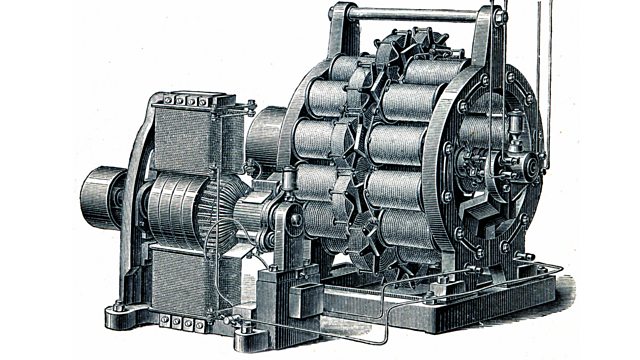Tim Harford tells the big story behind the way dynamos made electricity useful.
You might think electricity had an immediate and transformative impact on economic productivity. But you would be wrong. Thirty years after the invention of the useable light bulb, almost all American factories still relied on steam. Factory owners simply couldn’t see the advantage of electric power when their steam systems – in which they had invested a great deal of capital – worked just fine. Simply replacing a steam engine with an electric dynamo did little to improve efficiency. But the thing about a revolutionary technology is that it changes everything. And changing everything takes imagination. Instead of replacing their steam engines with electric dynamos, company bosses needed to re-design the whole factory. Only then would electric power leave steam behind. As Tim Harford explains, the same lag has applied to subsequent technological leaps – including computers. That revolution might be just beginning.
Producer: Ben Crighton
Editors: Richard Knight and Richard Vadon
(Image: Dynamo AC exciter Siemens, Credit: Igor Golovniov/Shutterstock)
Last on
Sources and related links
Robert M. Solow - 'We'd better watch out' New York Times Book Review, 12 July 1987
Robert Gordon - The Rise and Fall of American Growth (Oxford: Princeton University Press) 2016 p546-7
Paul A. David - The Computer and the dynamo: An historical perspective American Economic Review, May 1990
Paul A. David and Mark Thomas - The economic future in historical perspective OUP/British Academy, February 2006
Erik Brynjolfsoon and Lorin M. Hitt - Beyond Computation: Information technology, organizational transformation and business performance Journal of Economic Perspectives, Fall 2000
Broadcasts
- Sat 15 Jul 2017 02:50GMT�鶹�� World Service except Online, Australasia, News Internet & UK DAB/Freeview
- Sat 15 Jul 2017 19:50GMT�鶹�� World Service except East and Southern Africa, News Internet & West and Central Africa
- Mon 17 Jul 2017 03:50GMT�鶹�� World Service Online & UK DAB/Freeview only
Podcast
-
![]()
50 Things That Made the Modern Economy
The stories of inventions, ideas and innovations which helped create the economic world


